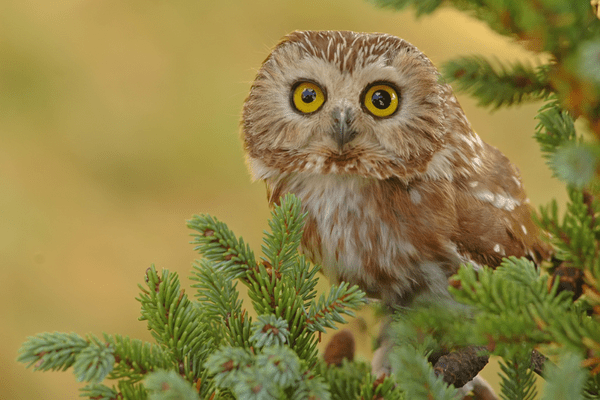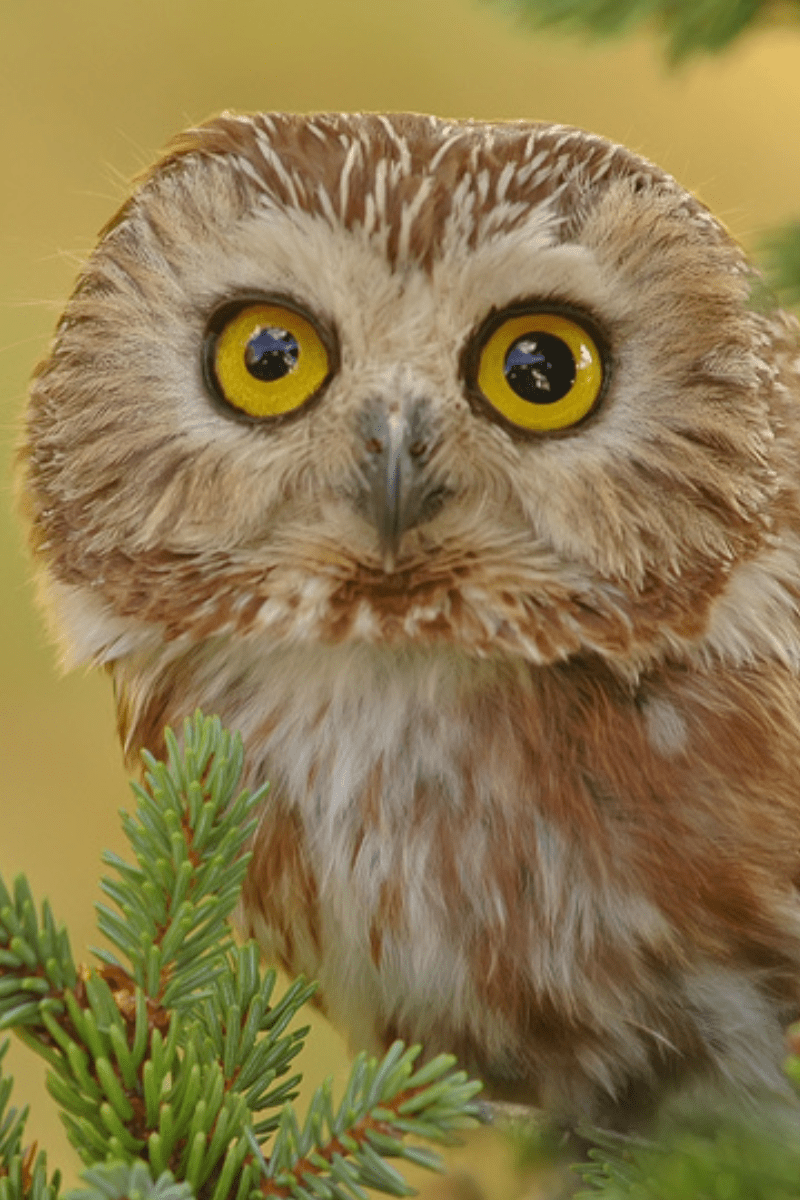Contents [show]
The Northern Saw-Whet Owl is a bird species with a number of other common names. Their names include White-Fronted Owl, Saw-Filer, Queen Charlotte Owl, Whetsaw, Sparrow Owl, and Kirkland’s Owl.
What’s the reason behind the name? Well, these beautiful creatures with yellow eyes and a large round head also sound like a saw that happens to be getting sharpened on a whetstone. Others believe the sounds made by the Northern saw-whet owl sound like sore teeth being sharpened.
Nevertheless, I’d like to share as much information as I possibly can with you today about the Northern saw-whet owl. I have a wide array of topics that I’d like to cover. The most critical areas include:
- The characteristics needed to identify the northern saw-whet owl
- Fun facts about the northern saw-whet owl
- Male and female Northern saw-whet owl differences, if any
- Feeding habits, dietary preferences, nesting behaviors, and migratory habits
- Other facts and information about the northern saw-whet owl
To learn more about this beautiful nocturnal creature, please continue below.
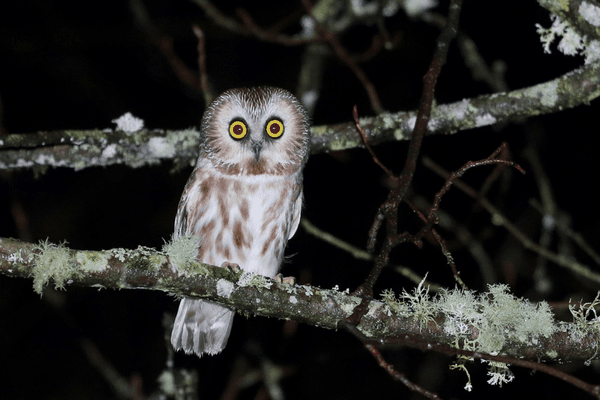
Northern saw-whet owl facts
- Common Name: Northern Saw-Whet Owl
- Scientific Name: Aegolius acadicus
- Scientific Family: Strigidae
- Life Span: 7-16 years
- Size: 6.7 to 8.7 inches
- Wingspan: 16.5 to 22.2 inches
- Weight: 1.9 to 5.3 oz
- Conservation status: Least Concern
Northern saw-whet owl: how-to identify
The northern saw-whet owl is typically made of a mottled brown color and it has a facial disk with white feathers. Their head is mostly brown but it also has white spots contained within. The adult Northern saw-whet owl also has yellow eyes. Juveniles, on the other hand, have a creamy yellow belly and breast and dark brown feathers.
Differences Between Male & Female
As far as plumage is concerned, there aren’t any differences between females and males. The size differences between male and female Northern saw-whet owls are an entirely different story. In fact, the female version of this bird species is roughly 25% heavier than her male counterparts.
Differences In Summer Plumage vs Winter Plumage
There are no major differences in plumage colors during summer, winter, fall, or spring. Their plumage remains the same color all year-round.
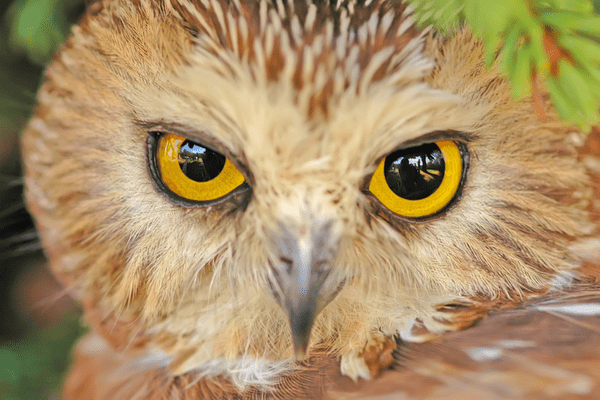
Where You’ll See A Northern saw-whet owl
The northern saw-whet owl is a bird that prefers living in the forest. You’ll find them all throughout northern North America because they use the extensive forests in this area for their breeding grounds.
On occasion, you will find them in open habitats as well, with an example being the shrubsteppe of the West. In the winter, they’ll be found in the southern and central United States in dense forests.
Northern saw-whet owl bird migration
During the winter, many of the northern saw-whet owls prefer to migrate to the lower elevations or they’ll migrate directly down south. Other Northern saw-whet owls tend to remain in the same place all year round.
They also irrupt once every four years. During this time, a great many Northern saw-whet owls in much larger numbers will head south. The migration will take place at night and the owls will use several different migratory routes across North America. This owl has the ability to cross large water expenses as well.
Northern saw-whet owl diet
The diet of the northern saw-whet owl is relatively straightforward and very similar to the majority of other owls. Since this beautiful bird lives in the forest, it is particularly partial to small rodents and other forest-dwelling creatures. For the most part, they tend to eat large birds and insects on occasion, and regularly eat young squirrels, mice, voles, and shrews.
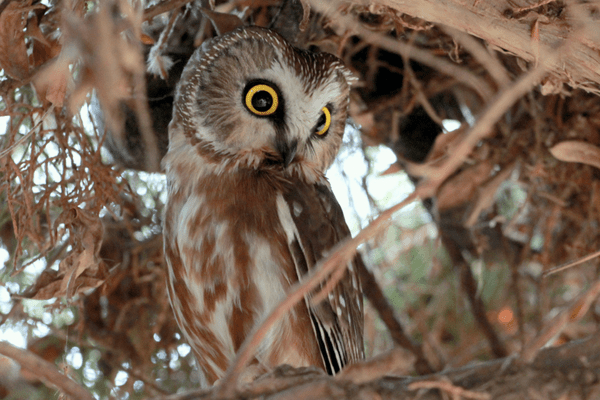
Northern saw-whet owl nesting
- Clutch Size: 4-7 eggs
- # of Broods: 1-2 broods
- Incubation Period: 26-29 days
- Nestling period: 27-34 days
- Egg Description: Smooth white
The female Northern saw-whet owl is the one that will likely choose the nesting site. Males do participate in this activity on occasion, and they will perch in a potential area for a future nesting site while giving off their call.
For the most part, their nests are typically taken from previously excavated holes left behind by pileated woodpeckers or Northern Flickers. They’re willing to use nesting boxes as well.
During nesting, the female will lay eggs and keep them at the bottom of the cavity in debris made of mammal bones, hair, grass, moss, twigs, and wood chips. The whole is usually 8-44 feet off the ground, and it tends to measure 19-18 inches deep and 3 inches wide. The entrance hall is usually only 2-3 inches across.
Northern saw-whet owl behavior
The Northern saw-whet owl is a nocturnal creature. It starts its day at late dusk when it begins its daily activities.
This isn’t a problem for this owl because it has phenomenal low-light vision. It can use its excellent night vision to find prey in the dark. Even though the owl will catch its prey in the middle of the night, it often keeps it safe and secure and then carries its prey to the place where it roosts during the daytime. It will stand on the prey until the next evening and then eat it.
If the northern saw-whet owl is ever discovered, it will completely sit still and avoid flying until the threat passes. Because of this behavior, many people consider this owl to be tame.
How-to attract northern saw-whet owls
The northern saw-whet owl is actually the smallest owl in all of North America. These little owls are actually quite ferocious and vicious predators of small rodents and mice. If you’re looking to keep your mice population under control, attracting these owls to your backyard is a good idea.
Some tips to do so are as follows:
- Think about putting a nesting box in your backyard. Put it relatively high up in a tree anywhere from 20 to 40 feet. They do not mind nesting in man-made boxes. Put up before late winter, which will increase your chances of attracting a Northern saw-whet owl tremendously.
- Another trick is to add a brush pile to your backyard. This is something that the northern saw-whet owl will find very attractive. You could also leave sticks and twigs scattered around your yard for the same purpose.
- Put a bird feeder in your backyard. The owl will not likely eat from it, but you can also add bird seeds to the ground below the feeder. These tiny predators will definitely find these seeds quite interesting and appealing.
- Adding a birdbath to your backyard is always a good idea as well. These smaller predators like having a fresh source of available water ready and on hand. The birdbath will give them a place to readily drink from and clean themselves whenever some refreshment is needed.
Northern saw-whet owl threats
The conservation status of the northern saw-whet owl is considered Least Concern. While the number of saw-whet owls in North America has likely declined, there hasn’t been any significant population loss to consider this an endangered or threatened species.
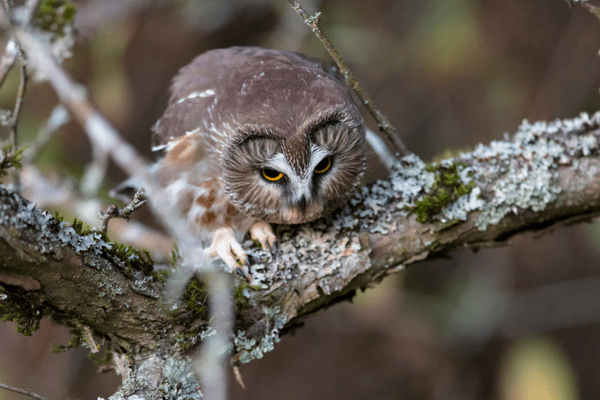
Northern saw-whet owl fun & interesting facts
- The colors of the plumage of adult and juvenile Northern saw-whet owls are very different. It’s so different that they even seem like two different owl species. By one year of age, the juvenile Northern saw-whet owl will molt for the first time. It will get its full adult plumage at this point and also reach sexual maturity.
- The male saw-whet owl handles all of the hunting and the female takes care of the incubation and brooding. When young owls reach 18 days old, the mother will leave the nest and begin to roost in a different location. She often avoids returning to the nest altogether, even avoiding helping her nestlings. Males, on the other hand, continue feeding the young nestlings even after the female is no longer in the nest. This will last for about a month once the young Northern saw-whet owls have fledged.
- During the active nesting period, the female saw-whet owl does a great job of taking care of the nest and she will keep it extremely clean. Once the area is abandoned by the female, and the male takes over completely to continue with feeding, the nest begins to accumulate a mess. By the time the nestlings leave the nest entirely, there is a layer of pellets, feces, and prey parts remaining in the nest.
- Since humans can approach Northern saw-whet owls, many look at them as team creatures. In fact, when it is roosting on a branch, they often allow human beings to pick them up, which seems hard to believe. More than likely, this is happening because the owl has never come into contact with human beings before in the dense forest habitat. So, they have no idea whether or not human beings are dangerous.
- These owls are known to keep extra food cash available. At one time, they could potentially kill as many as six mice. They will kill them and not even consume them during their hunt. They may even have cached prey that ends up freezing during the winter. When they retrieve the cached prey, the saw-whet owl will carry it with them to the roosting area and allow the prey to thaw out. It thaws out when the saw-whet owl lays on it, similar to incubating eggs.
- Burrowing Owl
- Barred Owl
- Elf Owl
- Boreal Owl
- Short-Eared Owl
- Spotted Owl
- Flammulated Owl
- Eastern Screech-Owl
- Long-Eared Owl
- Northern Hawk Owl
- Northern Pygmy-Owl
- Western Screech-Owl
- Snowy Owl
- Great Grey Owl

